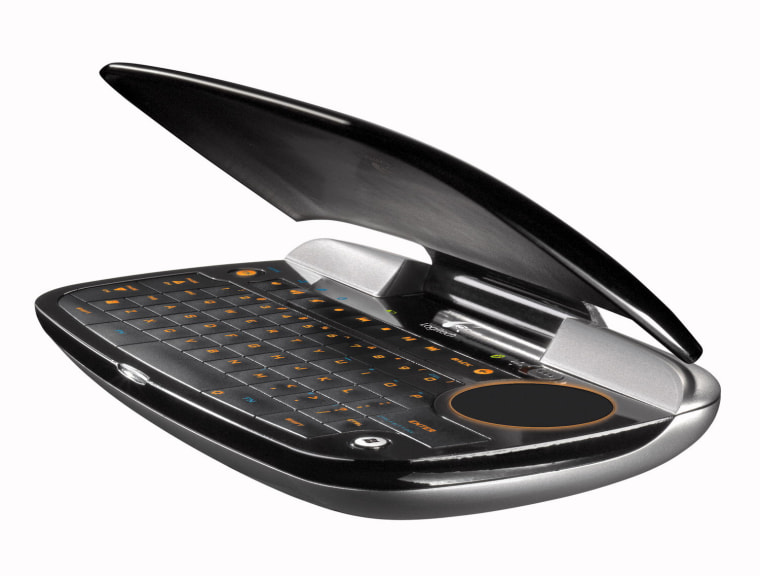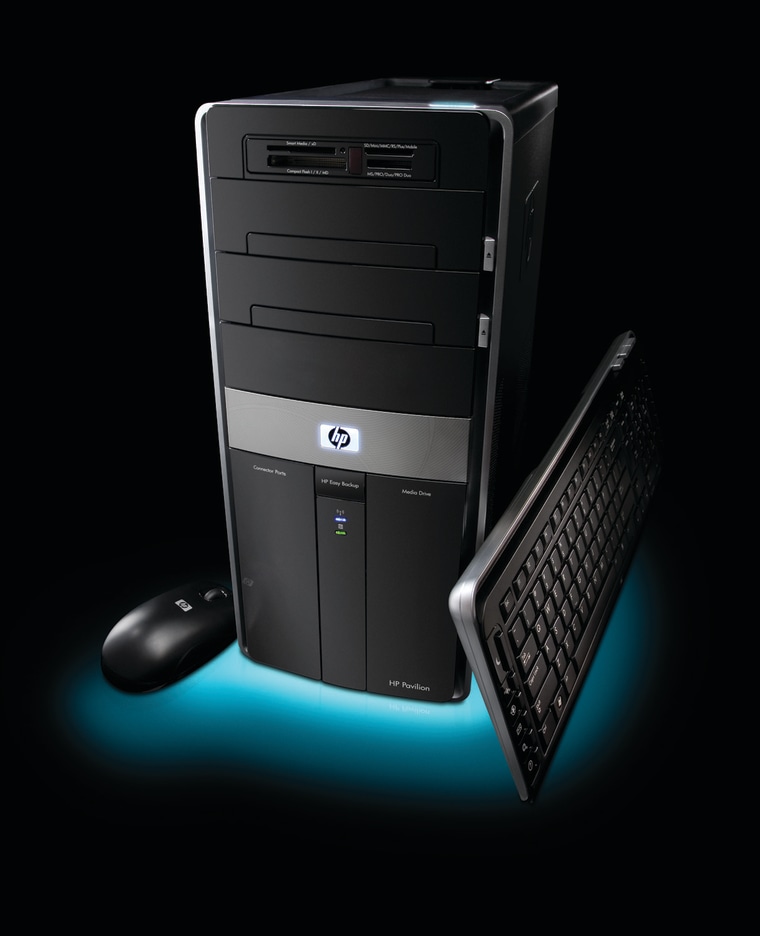A home theater PC may sound oxymoronic, but a computer in the living room makes more sense than you might think.
A properly configured PC can serve as a TiVo-style recorder, Blu-ray and DVD player, digital video archive and, lest we forget, a PC — all in one box. Pair a big-screen high-definition TV with a home theater PC, and you have a monitor that puts even those monster 30” PC displays to shame.
In the United States, between 1.5 million and nearly 2 million households have home theater PCs, out of 83 million households owning at least one PC, according to Parks Associates, which researches digital lifestyles.
Parks defines a home theater PC household as one with a computer running Microsoft Windows Media Center (a special edition of the XP operating system, or included with Vista Premium and Ultimate) that is connected to a TV and used for recording TV programming. (Msnbc.com is a joint venture of Microsoft and NBC Universal.)
Windows Media Center may be the most popular application powering home theater PCs, but there are other similar software packages, such as MythTV and SageTV, that work with computers that run Mac and Linux, as well as Windows.
All the programs provide similar services: TV guide listings, recording scheduling, video playlists and integration with video, music players and photo viewers. Windows Media Center continues to add services, such as movies and TV programs on-demand.
Home theater PCs aren’t for everyone, especially if your PC is usually relegated to e-mail and spreadsheet duties.
But this is one niche product that’s worth a careful look for anyone with a high-def TV.
The home theater PC profile
Whether you choose an off-the-shelf model or bravely decide to build a custom DIY special, all home theater PCs share some common features:
- A TV tuner PCI-E card — or two if want to watch and record two different programs — enables TV recording.
- Jumbo hard drives totaling 2 terabytes — equivalent to 2,000 gigabytes — and larger are handy for storing all that video. When determining your needs, consider that an hour of HD programming occupies about 6GB of space.
- If you have a high-definition TV with HDMI digital audio/video connections (and all newer models do), make sure the home theater PC comes with an HDMI output for maximum fidelity and one-cable connection convenience.
- For the most eye and ear-popping Blu-ray and HD programming playback, standard integrated video and audio hardware doesn’t cut it. Video cards from arch rivals NVIDIA and ATI, including NVIDIA’s GeForce 9000 and ATI’s Radeon HD3000 series, will provide plenty of graphics muscle.
- While most integrated audio processors in PCs will output 7.1 channels of surround sound, a dedicated PCI sound card will take some of the workload off of the computer’s CPU and produce higher-quality audio. Creative Technology’s X-Fi cards are among the best.
From budget to stylin’
The big names in computers all offer configurable home theater PC models in their line-ups.

HP’s Pavilion Elite m9300t series, for example, starts at $800 for a bare-bones home theater PC. Plan to spend closer to $1,600 for desirable upgrades like an Intel Core 2 Quad Q9300 processor, 512-megabyte NVIDIA 9500GS video card, 1-terabyte hard drive storage and a Blu-ray player and DVD burner combo drive.
Dell’s XPS 420 is priced in line with HP’s low-end home theater PC. A similarly equipped premium configuration runs about $1,700. The only major difference is that the high-performance XPS 420 uses an equally capable 512MB ATI HD3870 video card.
If you feel the need to make a fashion statement, the impeccably designed Sony VAIO TP25 Home Theater PC says it all.
This $3,000 machine has an Intel Core 2 duo processor, 500-GB hard drive and a 256-megabyte NVIDIA 8400M GT laptop video card.
While the components aren’t as beefy as HP and Dell’s PCs, everything is encased in what looks like an oversized hockey puck. Haute couture doesn’t come cheap.
Sony’s higher price is also justified by a Blu-ray burner for archiving video, and two external HDTV tuners that accommodate digital cable via a regular coaxial or cableCARD connection.
Blending into the living room
If you decide to build a home theater PC yourself, you'll have all the hardware HP, Dell and Sony use and then some to buy a la carte. More importantly, you'll determine what the finished product looks like.
One look at the HP or Dell home theater PCs could make you wonder how a traditional desktop tower will ever look at home in the living room. PC case manufacturers have crafted some gorgeous enclosures that look every bit the high-end home theater component.
Silverstone’s elegant Grandia GD02 case ($180) is available in brushed silver or black aluminum. The Antec Fusion Black 430 case ($219) further blurs the PC and home theater lines with a front vacuum fluorescent display and volume knob. Both horizontal format cases fit comfortably in a home theater rack.
DIYers are advised to pay attention to the sound levels produced by noisy cooling fans in cases, video cards and power supplies. Fan-less, passively cooled hardware is the ticket. Nothing will ruin a quiet, emotionally charged movie scene like the leaf blower-like blast of a PC fan kicking in.

The only other piece of gear that’s critical to home theater PC enjoyment is a wireless keyboard with a built-in track pad since you’ll be operating the PC from the couch, not behind a desk.
Some universal remotes like the Logitech Harmony 1000 will control basic Windows Media Center functions, and part of the fun of having a home theater PC is surfing the Web on a big HDTV wide-screen.
Logitech’s diNovo Mini ($150) is an ingeniously designed, palm-sized keyboard that’s perfect for home theater PC use. The Mini’s click/track pad and backlit keys make PC navigating in a dark living room a breeze.
Media extenders and networked HDTV
The home theater PC market is evolving beyond the PC to include media extenders and networked HDTVs.
If your HDTV and home theater PC are in separate rooms, a media extender connected to the TV acts as a receiver for any content on the home theater PC. A mirror of the Windows Media Center application appears on the TV, and it’s as if the PC is connected directly.
Among some media extenders: HP’s MediaSmart Connect ($350) and the Linksys DMA2100 Media Extender ($250), as well as the Xbox 360 ($300).
While media extenders will work over a wireless network, video quality, especially smooth streaming, is much more reliable over a wired network.
If you’d rather not have cables running across the living room floor, consider a clever technology called HomePlug (kits start at about $150). Netgear, Linksys and ZyXEL all market similar HomePlug products.
Setting up a HomePlug network couldn't be simpler. Just plug one adapter into an electrical outlet close to your wireless hub or router. Make a connection between the router and adapter with an Ethernet cable. Presto! Now your in-wall electrical system is a high-speed data network.
Plug in another HomePlug adapter to an outlet close to your home theater, run another Ethernet cable to the media extender and you'll be enjoying data transmission speeds at least four times as fast as 802.11g or wireless-G. Videos will stream buttery smooth.
The latest entry into the home theater PC media extender field is Samsung’s MediaLive adapter, due out in August at an estimated price of $200. This tidy unit mounts on the back of most 2008 model Samsung HDTVs, and provides full media center capabilities over a wireless or wired network connection.
